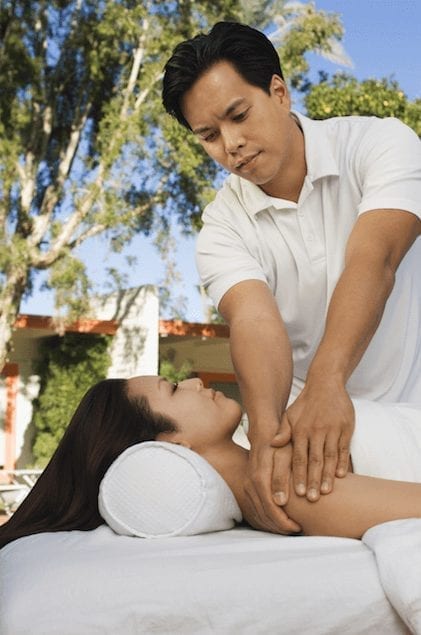Holistic healthcare has garnered increasing recognition in the mainstream medical field. As a result, people are now evaluating how massage is so much more than a mini-vacation for your mind and body. The litany of health benefits, many of which are long-term, is drawing more and more patients to the massage table. Massage can be tailored to the individual and provide almost-instant relief for many ailments, including chronic pain, insomnia, depression, and sports injury recovery—massage is more than pampering.
People most commonly seek massage to alleviate pain and improve relaxation, but these two benefits only touch upon the surface of all that massage can offer. Massage has been used for thousands of years in ancient China and Japan, where it was looked upon less as a luxury than a healing method. This mindset is still present in modern day China, where hospitals prescribe massage and acupuncture alongside IVs and modern medication. Happily, the United States is catching on to this mindset as well.
Specialized Techniques in Massage Therapy
The back and neck constitute a large part of the body. These two areas are particularly prone to tension accumulation and when this occurs, it can cause the affected individual great physical and psychological pain. Acute lower back pain, described as pain that has lasted less than six weeks in duration, may resolve itself with little or no intervention. However, lower back pain that is sub-acute or chronic (meaning it lasts longer than six weeks in duration), is likely to require greater focus. There are multiple forms of massage for lower back pain. Circulatory massage and Thai massage have been proven to be especially effective at relieving chronic lower back pain.
Check out PCOM’s Massage Programs: San Diego – New York
Circulatory Massage for Back Pain
Circulatory massage is a technique that relaxes muscles in the area in receipt of the massage therapy through the application of pressure. The area is rubbed in the direction in which blood flows back to the heart. Thai massage, on the other hand, is a technique that pulls and stretches the area of the back and neck. Massage oils may be used to reduce friction during massage. Massage is associated with improved blood circulation and this is thought to aid the recovery of muscle strains and pains. Massage relaxes the muscles, allowing them to achieve an improved motion range. This relaxation of the muscles is indicated as beneficial in the prevention of insomnia. Massage results in an increase in the levels of endorphins in the body, the chemicals associated with improved mental well-being, and it is this that leads to the effectiveness for managing chronic back pain.
Circulatory massage therapy uses five different forms of massage strokes. The first form of stroke involves the application of stroke in a sliding or gliding way (smooth long strokes), most commonly known as effleurage. The second form of stroke is known as petrissage, which involves applying strokes in a kneading manner. The third form is known as tapotement, and the strokes are applied in a systematic and rhythmic tapping/slapping manner. The fourth form is known as friction stroke, where firm, deep, circular motions are applied. The last stroke is known as vibration stroke, where a rapid shake or vibration is applied to the targeted muscle.
Are you interested in becoming a certified massage therapist?
Visit the links below to explore our massage therapy programs at a campus near you:
Tui Na: An Ancient Form of Healing
Tui Na is a form of massage that draws upon principles found in Chinese medicine. Tui Na incorporates acupoints (the specific points on the body studied by Chinese medicine practitioners that are also used in acupuncture), and is performed regularly in Chinese hospitals. Dating back to 1700 B.C., Tui Na is one of the original forms of Asian bodywork—massage modalities that draw upon Eastern medicine teachings. While many techniques of Tui Na such as gilding, kneading, rotation, and rocking are similar to Western forms of massage, the intent of Tui Na is more than therapeutic. This massage utilizes hand techniques to restore correct anatomical musculoskeletal relationships, neuromuscular patterns, and to increase the circulation of blood and qi to remove biochemical irritants. One of Tui Na’s advantages over more simple forms of massage is its ability to focus on specific problems like sciatica, arthritis, and muscle spasms, as well as chronic conditions like insomnia, constipation, and migraines. Since it works with musculoskeletal relationships, Tui Na can be particularly effective for patients with neck and back issues related to poor posture or desk-job complaints.
With an experienced massage therapist, you can anticipate chronic pain or back problems before they start. Massage can help to not only prevent a current problem from re-occurring, but to foresee and take measures against other muscle pains. In addition this, massage can boost endorphins to enhance mood, increase relaxation, and have a calming effect that seeps into other areas of your life.
Check out PCOM’s Massage Programs: San Diego – New York
Featured Posts:

